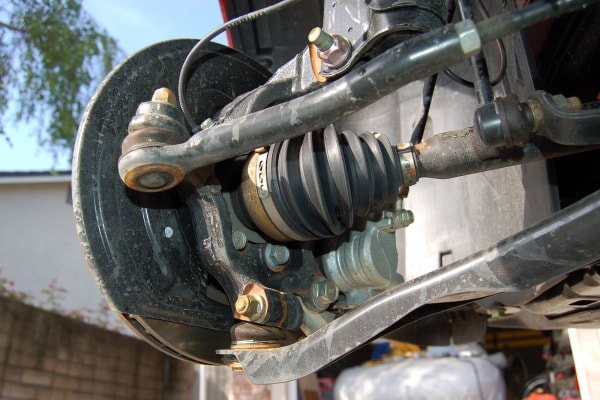
Cars like the 2011 Nissan Leaf, Toyota Prius and Honda Insight are all about their unique fancy-pants drivetrains, but they're supposed to be affordable, too. Experience tells us this combination produces few surprises in the suspension department.
Still, the Leaf was the landslide winner in our recent suspension walkaround poll. You asked for it, you got it. Here's the all-new 2011 Nissan Leaf in a compromising position in my driveway.

To the surprise of no one, the Leaf's front end is propped up by MacPherson struts.

The lower control arm (yellow) is of the one-piece stamped steel variety, and it pivots on two simple bushings.

The Leaf's electric-assist power steering (white) operates from behind, just as it would in any other front-drive machine with a transverse engine -- or in this case a transverse electric motor.
A long slender link (yellow) connects the stabilizer bar directly to the strut housing for a 1:1 motion ratio that extracts the maximum efficiency from the stabilizer bar.

In keeping with the mission and price point of this car, the knuckle is made of cast iron. Remember, all of the cost resides in the batteries and electric drivetrain.

The stabilizer bar (yellow) is mounted behind the steering rack, so it must bend and turn along a tortured path to arrive where the drop link can meet it.
Check out how small the locating bushings are for the L-shaped lower control arm. We can't see it, but the front one in the crook of the L is bound to be much firmer because it handles most of the lateral cornering loads. Because it's so small, it might just be a pillow ball in this case.
The rear one will be softer so it can absorb any fore-aft impacts seen at the wheel. Imagine whacking the ball joint in the foreground left-to-right with a hammer. The harder forward bush stays put and acts as a pivot, sending your hammer blow into the picture toward the center of the car at the rear bush. That's how the fore-aft component of a pothole strike gets absorbed.
Of course the up-down portion of the pothole strike gets handled by...

...the spring and damper, of course. Yes, it rained the day before I shot these pictures. Dirt everywhere.

The most surprising element of the Nissan Leaf's suspension has got to be these brakes. As you can see they are two-piston calipers. I'd have thought a car of this size and weight would have no trouble with single-piston calipers. We almost never see dual-piston sliders until we get to something the size and weight of a Ford Flex.
And that's before you factor in the serious amounts of regenerative braking afforded by the electric motor. These babies are going to be very lightly used much of the time.
Still, the brakes have to be certified without the help of regenerative braking, and the Leaf does weigh almost 3,400 pounds. Its small wheels mean small rotors, which means little leverage for the brake calipers. It may well add up. Nissan wouldn't go to the extra expense unless it was warranted.

This is a symmetrical brake casting used on both sides of the car. If you look carefully you'll see that the bleed fitting at the top has been screwed into the letter R, leaving the letter L opposite untouched to signify this as a left front brake. On the other side the L is pierced and the R is intact. The big blue inked R means something else entirely.
The slender lines indicate the pins on which the caliper slides as the brakes are pressed.

Out back, the Leaf is suspended by a simple twist beam axle.

A twist beam is one large piece that's welded together from several smaller parts. Because of this it's not a fully independent type of suspension, but we can call it semi-independent because the central beam that spans the car is designed to twist so the wheels do experience at least some independence. In reality a twist beam axle is a giant stabilizer bar with wheels on the floppy ends.

Technically, we can't call this part the stabilizer bar because the whole twist beam is a stabilizer bar, but this welded-in supplemental stabilizer bar serves no other purpose than to increase the roll stiffness of the entire twisty beam to a point where the engineers are happy.

Because the spring platform and the other welded-on bits act like huge gussets, the twist beam doesn't twist much until you venture inboard of all this stuff to where the beam is just a beam.

This bushing and its opposite number on the other side are the only places where the twist beam is located in 3D space and attached to the car. These pivot bushings, therefore, are very important.
In the interest of harshness -- the fore-aft component of impacts -- you want them soft. But if they're soft they will deflect in corners and create the dreaded roll toe-out, otherwise known as roll oversteer. Bad news.

Ventilated rear rotors and single-piston sliding calipers slow things down in the rear, but the Leaf's parking brake is a cable operated drum that's hidden inside the rotor's "hat" section.

Bridgestone Ecopia low rolling-resistance tires are the standard fitment. They weigh 41.5 pounds mounted and ready to go on their cast-aluminum wheels.

We saw nothing of the Leaf's electric drive system or its batteries this time because it's all hidden by these aerodynamic belly pans. Maybe next time I'll dig out some wrenches and take a peak. I'll need a more traditional 2-post garage lift to do that justice, I think.


